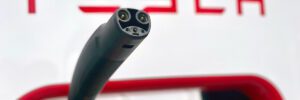The poor reliability of public EV chargers is an industry-wide scandal. A year ago, when legacy automakers started adopting Tesla’s NACS charging system, many seemed to assume that this would soon solve all the problems. More sober observers told us that one of the main reasons Tesla’s Superchargers have been so reliable is that vehicles, chargers and network were all controlled by a single company—and that advantage was always going to disappear as soon as other brands’ EVs started using the Superchargers.
Here at Charged, we were also skeptical about the wisdom of granting so much power over the charging scene to any one company (especially one with a loose cannon at the helm). Those concerns were arguably validated this week when Tesla reportedly laid off its entire Supercharger team and threw the industry into turmoil.
It remains to be seen how the surprise move will affect Tesla and other industry players, but whatever ends up happening, Tesla’s NACS has morphed into SAE J3400, and it isn’t going away. Interoperability testing has been going on for months, and will continue. One of the companies at the center of this is EcoG, which provides an operating system that powers EV chargers from many different brands.
“Tesla might test its EVs with 5 to 10 charger types, but the broader challenge is much more complex.”
“Tesla is doing better because there you have this single entity controlling both the charger and the vehicle,” EcoG CEO Joerg Heuer told Charged in a recent interview (which took place before the latest Tesla news). “Most people look to the charger, but we also look to the vehicle. We provide a Reliability Index for vehicles, and we plan to publish the second edition sometime later this year.”
“Right now, we’re looking at a landscape with about 100 charging station manufacturers and a growing number of EV manufacturers,” said Heuer. “Tesla might test its EVs with 5 to 10 charger types, but the broader challenge is much more complex. To achieve a truly seamless charging experience for any EV driver, we’re tasked with ensuring that every electric car can use any charging station. Achieving this interoperability means testing over 500 different combinations of cars and chargers.”
“Achieving…interoperability means testing over 500 different combinations of cars and chargers.””
One thing that will hopefully facilitate interoperability over the coming years is the fact that NACS/J3400 is not radically different from CCS. “The plug is quite different, but all the processing behind it is quite similar,” Heuer explains. “That’s also the reason why in Europe they can easily use a CCS plug, and in US they have these adapters. Of course, in the foreground, it looks very different because the plug looks different. But in the background, the automation, the really complex stuff, that’s quite similar.”
“About two weeks after the announcement that Ford would adopt NACS, a customer of ours just added a Tesla cable to their CCS station, and the thing worked with a Tesla vehicle,” Heuer told us. “That’s the nice thing. It’s no longer this competition between CHAdeMO and CCS, which were really totally different systems. Compared to CHAdeMO, I would say 90% or 95% is really the same between CCS and NACS.”
Some find it ironic that in Europe, Tesla adopted the CCS plug, whereas in the US, vehicle OEMs and EVSE manufacturers are adopting the Tesla plug. Heuer explains that there are several reasons for that. “One reason is that in Europe, we have a three-phase AC system, so this would be a shortcoming of the Tesla plug because then they would only be able to charge one phase. In Europe, we would then be limited to three kilowatts in most countries, maybe maximum seven. That’s one physical aspect.”
A second difference between the North American and European markets is that the latter has developed in a less vertically-integrated way. “The networks started quite early with roaming and so on—it was not so dependent on what network or mobility service provider you contracted with. So the advantage Tesla had compared to the rest of the networks was not so significant.”
Source: EcoG
Source: Electric Vehicles Magazine


